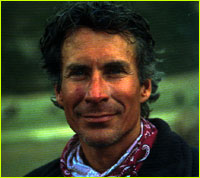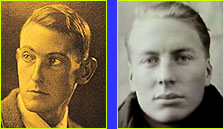 |
 Hear Breashears via RealAudio: 28.8 | ISDN |
 |
May 3, 1999 On the evening of Sunday, May 2nd, search team members Dave Hahn, Conrad Anker, Tap Richards, Jake Norton, and Andy Politz reported that they had found the body of George Mallory. David Breashears, mountaineer, cinematographer of the Everest IMAX Filming Expedition, and author of High Exposure: An Enduring Passion for Everest and Unforgiving Places, explains the significance of this find during an interview held today in NOVA's offices in Boston. (Breashears is not part of the current expedition). NOVA: What is your first reaction to the news that George Mallory has been found? BREASHEARS: I think it's incredibly exciting that they've finally found George Mallory's body. I organized an expedition in 1986 with my friend Andrew Harvard and Tom Holzel, and we went out to look for the bodies of Mallory and Irvine. It was a very windy year and the snow was very deep, and we didn't get high enough to find them. No one has made a real, concerted effort since then to look for them. The astonishing thing is that we all thought, given the evidence we had, that they were going to find Andrew Irvine on the area on the terrace below where his ice axe was found. If you find a climber's ice axe, lying on a slab, it can only be the site of an accident. No climber, high on Everest, would willingly abandon their ice axe and leave it behind - it's far too useful. So, lying on the terrace, a thousand feet below the ice axe, should have been Irvine, but it wasn't - it was George Mallory, one of the great figures in the history of mountaineering, the man who coined the phrase: "because it's there," when asked why climb Everest. NOVA: Does it surprise you that a camera has not yet been found? | ||
|
28.8 | ISDN |
BREASHEARS: The team was searching this terrace, and it is incredibly arduous, to get out and have to function well, think hard, and concentrate at 27,000 feet - I know from having filmed in those elevations and altitudes for many years. They didn't find a camera, the most important single clue in letting us know whether Mallory and Irvine reached the summit. I don't really believe they did [reach the summit], but a key clue is the camera. I wouldn't have expected that they would find it with Mallory. Mallory knew very well what the first ascent of the world's highest peak would mean to his career, and to me it wouldn't make sense for you, the lead climber, to be taking pictures of the junior climber. It would be the junior climber, the twenty-two year old Andrew Irvine taking pictures of the lead climber, the man of Everest, the man on his third trip to Everest, George Mallory. So if I were to be looking for a camera, I would be looking for Sandy Irvine's body. NOVA: What is next on the agenda of the expedition? | |||
|
28.8 | ISDN |
BREASHEARS: The expedition had a climb from Camp Five up to the site of Camp Six. I believe they established Camp Six and then went out searching on the terrace, which is just hard work, and then, after a night at Camp V, they returned to Advance Base Camp. Now, they've walked back down to Base Camp. It's how we climb mountains, we call it "climb high, sleep low:" you go up high, and you come down and sleep at elevations that are more comfortable. But by going up, you trigger the body's response to altitude and it begins to acclimatize. So they've been high, working quite hard at 27,000 feet. They've descended now to Base Camp, at 16,500 feet. I assume they'll rest for two or three days, maybe more and get their strength back. You sleep well at base camp, you eat better at base camp, you digest food better at Base Camp. And then they are going to return to the mountain and back to the high camp and once again, I assume, Eric and his team members will go out on the terrace, search the terrace, come back to their camp. Then, the next day, they might make an attempt on the summit. And that should be happening between the next week to ten days. NOVA: How does this find help to solve the mystery of Mallory and Irvine? | |||
|
28.8 | ISDN |
NOVA: Can you describe some of the other experiments the climbers hope to perform on this expedition? | |||
|
28.8 | ISDN |
BREASHEARS: From what I understand, Conrad Anker, who is one of the members of the team and one of America's finest Alpinists and free-climbers, wants to climb the Second Step, the very, very famous rock barrier at 28,700 feet on the Northeast Ridge. It would have been the single most difficult piece of climbing Mallory and Irvine would have had to overcome to reach the top—and quite something to have descended as well. There has been a ladder fixed there since 1975. The Chinese found it so difficult, they put up an aluminum ladder. Now, all teams climbing that route ... have used either fixed ropes hanging there or the ladder. Conrad is going to try to avoid the ropes and avoid the ladder and climb it just as Mallory would have had to June 8, 1924: standing at the base, with his own hands and feet, no other aids. It's going to be very interesting to hear Conrad's assessment of the difficulties of the Second Step and the assessment of whether climbers of certain known abilities in the twenties could have gotten up. NOVA: How does this news effect your perception of Mount Everest? | |||
|
28.8 | ISDN |
BREASHEARS: I think this is such an exciting moment for people. Mallory is a great figure in the history of Himalayan mountaineering. I really don't hold out any hope that they could have climbed it, I never entertained that fantasy, but it is a piece of history and we know where he lies now and it's given us some clues as to his demise. We didn't know where he'd fallen on the mountain. Maybe he'd fallen off near the summit onto the Kangshung face, the other way, where they never would have found him. But, for me, it's the end of a large part of the mystery. If they find a camera that may answer something. But all those years that I've been going to Everest, four times to the North side, gazing up there, thinking about these incredible men trying for the summit of Everest in 1924, in cotton wind suits and tweed jackets, for me, I feel a bit reassured and a bit resolved that we know where George Mallory is. David Breashears is an elite mountaineer and the acclaimed cinematographer of the Everest IMAX Filming Expedition. He is one of America's leading Everest mountaineers: veteran of fourteen expeditions to Mount Everest, several of which he organized and led, he has reached the summit four times. In 1983, he transmitted the first live pictures from the summit of Mount Everest and in 1985 became the first American to twice reach its summit. Breashears' recently-published book, High Exposure: An Enduring Passion for Everest and Unforgiving Places chronicles his early years and growth as a climber and filmmaker, culminating in the events and filming of the fateful season of 1996 in which eight died on Mount Everest in one massive storm. Unanswered Questions (May 25, 1999) Forty-Eight Yaks (May 21, 1999) On Top of the World (May 17, 1999) Summit Team Moves Higher (May 16, 1999) Still at Camp V (May 15, 1999) Snow Bound (May 14, 1999) Outsmarting the Weather (May 13, 1999) Last Trip Up (May 12, 1999) Up to ABC/The Rescue (May 11, 1999) The Image of Mallory (May 8, 1999) In Extremis (May 7, 1999) Pieces of the Puzzle (May 6, 1999) Dearest George (May 5, 1999) Mallory's Discoverers Return (May 4, 1999) Mallory Reported Found (May 3, 1999) Waiting in Silence (May 1, 1999) Up to the Search Site (April 30, 1999) To the North Col (April 29, 1999) Waiting out the Wind (April 28, 1999) Search About to Begin (April 25, 1999) Pitching a 1933 Tent (April 23, 1999) Early Camp Found at 21,750 Feet on Everest (April 20, 1999) Up to Base Camp (April 23, 1999) Photo: R. Schauer. Members of the press: click here for NOVA/PBS ONLINE "Lost on Everest" media relations contacts. Lost on Everest | High Exposure | Climb | History & Culture | Earth, Wind, & Ice E-mail | Previous Expeditions | Resources | Site Map | Everest Home Editor's Picks | Previous Sites | Join Us/E-mail | TV/Web Schedule About NOVA | Teachers | Site Map | Shop | Jobs | Search | To print PBS Online | NOVA Online | WGBH © | Updated November 2000 |
|||
 David Breashears
David Breashears
 George Mallory (L) and Andrew "Sandy" Irvine (R)
George Mallory (L) and Andrew "Sandy" Irvine (R)